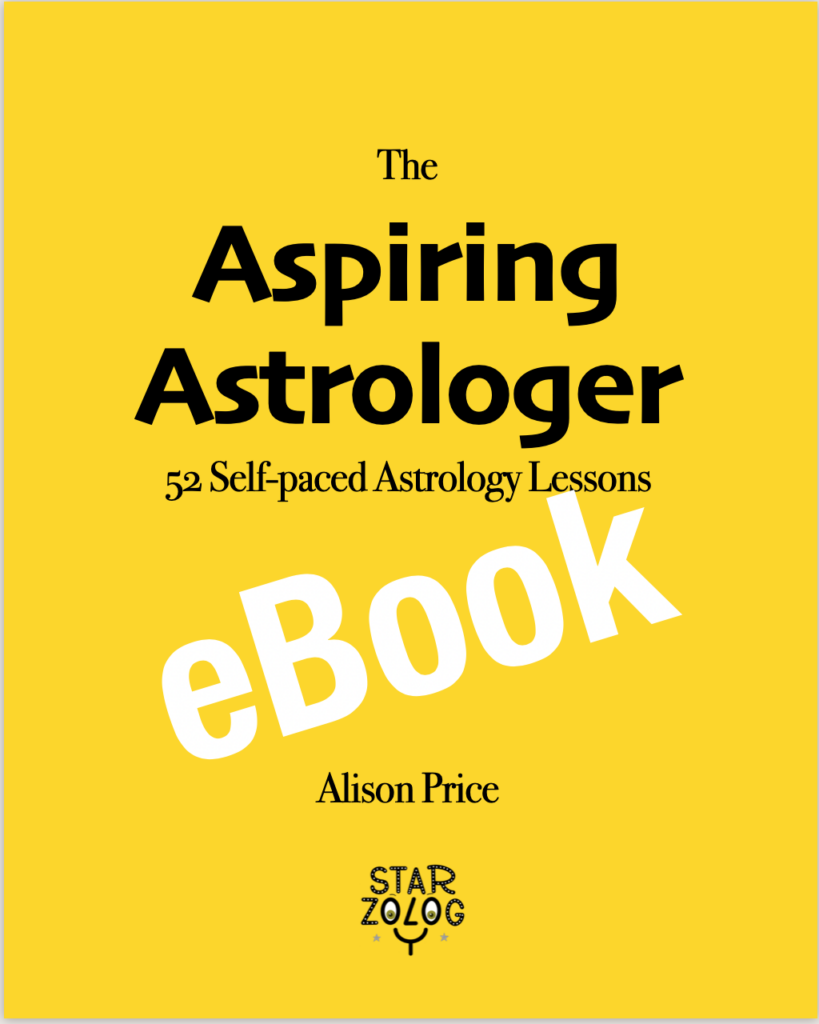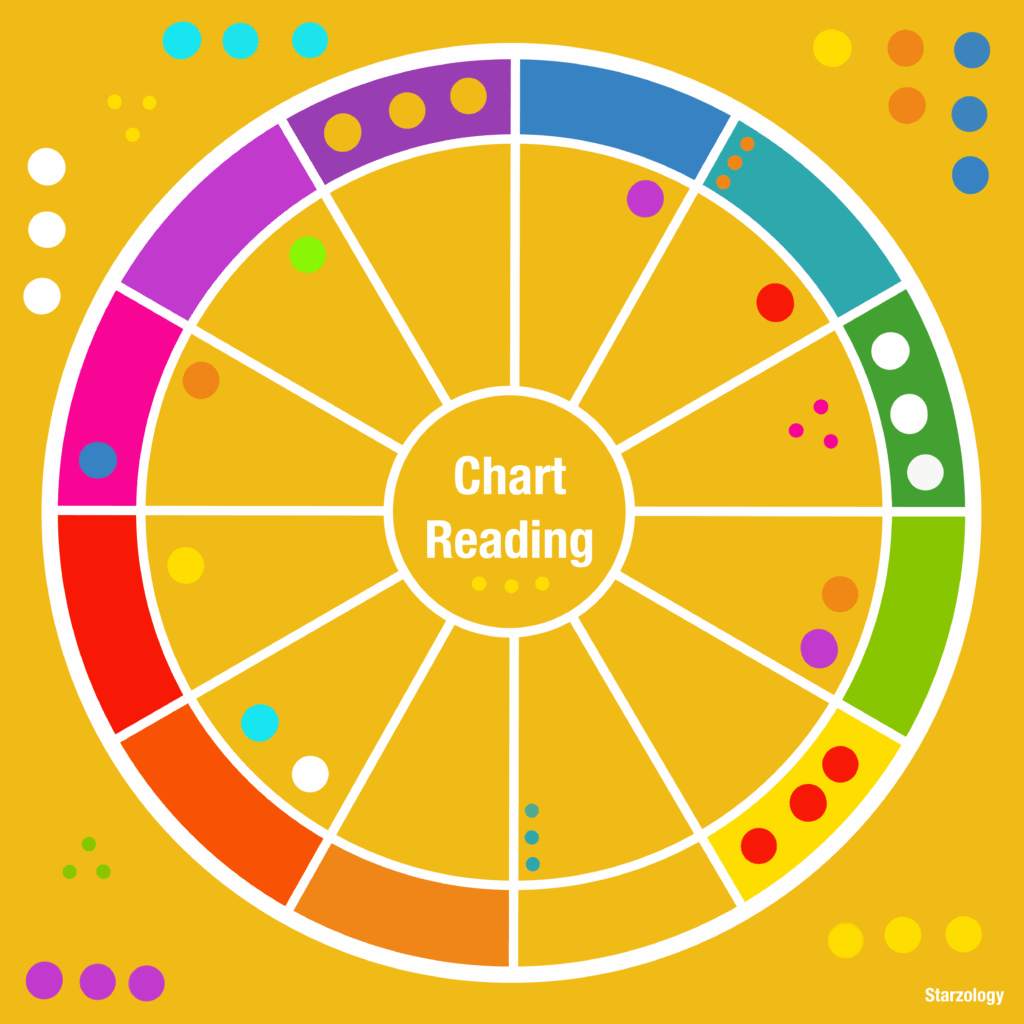The Starzology monthly horoscope overview provides all the ingresses, stations and lunations for each month with a short interpretation.

Taurpio
Author: Alison Price – Published: February 2024
Background
In early 2024 I had the idea to offer online chart interpretations. These would be for listeners of our podcast.
The online astrology reading is not a face-to-face consultation, but it is an interpretaion that is discussed on the podcast or perhaps on Youtube. I considered inviting Arwynne to join in the conversation on some of them and she was excited to chim in on this, the first online astrology reading. I am happy that Arwynne joined me for the interpretation on the podcast.
Also please note that there was so much interest in the Online Astrology Readings that there is an 8 month waitlist because we need to catch up with all the readings already requested.
Chart Details
Birth City
When starting any chart reading you need the birth details. Taurpio’s was born at 6:28 pm, on the 28th April 1983, in Wellington, New Zealand.
Current City
Because I will look at the transits, I asked where she was living now and it turns out that she now resides in Perth, Australia.

Balances
Visible Planets
Only counting the visible planets.
Hemispheres
Moving on to the hemispheres, the four Hemispheres are balanced.
Quadrants
The four Quadrants are balanced.
Strong
Mode
Fixed = 5
Triple Division
2nd Triple Division = 4
Sign
Taurus = 5
House
6th house 6
Chart Shape
Shape see saw chart typically has many oppositions and not many trines. There are usually two sides to the chart.
Ascendant Complex
Sign and Degree
The Ascendant is at 28° Scorpio.
First House Planets
Part of the Ascendant complex are any planets in the 1st house. Planets in the angular 1st house are well placed. In Taurpio’s chart there are two 1st house planets. Uranus is conjoined Jupiter in the first house in Sagittarius.
Ascendant Aspects
Ascendant Neutral Aspects
The Ascendant is conjoined the Moon in fall in Scorpio and in the sensitive Ascendant Gauquelin sector.
Ascendant Hard Aspects
The Ascendant is opposite Mercury and Chiron both in Taurus in the 6th house.
Chart Ruler Complex: Mars
Mars
As Scorpio is the Ascendant sign and because Mars rules Scorpio, Mars becomes the first chart ruler.
Mars Sign
The chart ruler, Mars, is in detriment in Taurus and gets a score of -5.
Mars House
Mars is in the 6th house.
Mars Position
Mars is the Evening Planet as it sets after the Sun.
Mars’ Aspects
Mars Aspects Neutral
Mars is conjoined Mercury and the Part of Fortune.
Mars Aspects Hard
Mars is opposite the Moon.
Chart Ruler Complex: Pluto
Chart Ruler’s Sign
The second chart ruler, after Mars, is Pluto as it is the modern ruler of Scorpio.
Chart Ruler’s Sign
Pluto is in Libra.
Chart Ruler’s House
Pluto is in the 12th house.
Pluto’s Aspects
Pluto Aspects Neutral
Pluto is conjoined Saturn.
Pluto Aspects Soft
Pluto is sextile Neptune. This is a generational aspects and millions of people have it in their chart.
Pluto is trine the North Node and sextile the South Node.
Pluto Quincunx Chiron
Sun Complex
Sun Sign
The Sun is in Taurus.
Sun House
The Sun is in the 6th house.
Sun Rules
The Sun rules the Midheaven, the 6th house, the Eastern Hemisphere and the 4th Quadrant (Q4).
Sun Aspects
Sun Aspects Neutral
The Sun conjoins Mars and the Part of Fortune.
Sun Aspects Hard
The Sun is opposite Saturn.
Sun Aspects Adjustments
The Sun is quincunx Jupiter and Uranus.
Moon Complex
Moon Sign
The Moon is in Scorpio which is not well placed as it is in Fall and gets a score of -4.
Moon House
The Moon is in the private 12th House.
Moon Rules
The Moon only rules the 9th house.
Lunar Phase
This chart has a Full Moon phase where the light of the Moon is very bright.
Moon Position
The Moon is in the Ascendant Gauquelin sector which gives it weight.
Moon Aspects
Moon Aspects Neutral
The Moon is conjoined the Ascendant.
Moon Aspects Hard
The Moon is opposite Mercury, Mars, Chiron and the Part of Fortune.
Dispositor Tree
Dispositor trees are another way to visualize the chart. This chart has two dispositor trees. The first is a Planet in Sign Tree, the Jupiter one, and the second is the Mutual Reception Tree with Mercury and Venus.
See the Dispositor Tree diagram further down.
Planet is Sign: Dispositor Tree
Jupiter is in its own sign of Sagittarius and so is well placed on the top line. Below Jupiter is Uranus and Neptune in Sagittarius. Jupiter disposes both Uranus and Neptune.
Mutual Reception Dispositor Tree
The two planets in mutual reception are Mercury and Venus. Mercury is in Venus’ sign of Taurus and Venus is in Mercury’s sign of Gemini. This means that Mercury and Venus are in mutual reception and have equal status in the dispositor tree. They go on the top line.
Below Venus is Chiron, Mars and the Sun in Taurus and Pluto in Libra. Venus disposes Chiron, Mars and the Sun. Below Mars is the Moon and Saturn in Scorpio. Mars disposes the Moon and Saturn. There are no planets below Mercury because there are no other planets other than Venus in either of Mercury’s signs Gemini and Virgo.
Links and Aspects
I always note any links (the arrows) that are also aspects in the chart. In this chart Jupiter is linked to Uranus and there is a conjunction between the two. The Moon and Mars are linked in the tree and they are in opposition to each other as well. The aspected links are maked in red.
Chart Rulers
I always highlight the chart rulers in a dispositor tree and in this chart the two chart rulers are Mars and Scorpio which are highlighted in yellow.

Main Comments from Taurpio
These are the main comments and question that Taurpio wanted us to focus on. Arwynne and I can’t cover everything in a 30 minute podcast, so we did what we could.
Reading Special Focus?
“How to make the best of the delightful pluto square pluto transit I’m going through. Somewhat challenging.”
Your Favourite Starzology Astrology Podcast Episodes?
“I love them all. I find yourself and Arwynne super engaging. I really enjoy the planets through the signs, also when you talk about generational transits i.e Chiron return. Also enjoyed the Oriental planet, mine’s Neptune.”
Additionally…
“I feel like I have a lot of polarity in my chart, very fixed energy of ♉️ and ♏️. Also interested to hear about the axis of the 6th and 12th houses.”
Forecasting: Transits recent Past
Pluto square Pluto
This transformative aspects which was in place for the past two years has finally cleared. Taurpio specifically asked about this aspect and we discuss in more in the podcast episode.
Forecasting: Transits Upcoming
Pluto square Saturn
Pluto is squaring Saturn now and will do so another two times during the course of 2024. This is marked in orange on the Dispositor Tree.

Graphic Ephemeris
Graphic Ephemeris Defaults
I always set my Graphic Ephemeris defaults as follows:
- 45 degrees.
- Eighth harmonic aspects.
- Two years.
- Start six months ago.
- Go ahead for 18 months.

Graphic Ephemeris: What to Add
Once I have the Graphic Ephemeris printed out, I begin to add extra forecasting details. These other forecasting techniques are great at underlying what has already been brought forward in the transits.
Graphic Ephemeris: Eclipses
I look for lunar and solar eclipses for the next 12 months. I add any eclipses that conjoin the natal chart planets or points.
Graphic Ephemeris: Secondary Progressions
For the secondary progressions, I add any secondary progressed planet that changes of sign or house in teh next year. Additionally I add any secondary progressed planet of angle that conjoins a natal planet or points.
Graphic Ephemeris: Solar Arc Directions
I add the Solar arc directed planet changes of sign or house. I also add any Solar arc directed planets that conjoin a natal plants or point. See more on this later.
Solar Return Chart
The solar return chart can standalone and be interpreted by itself. This is another direct forecasting technique that I use after transits and eclipses. I always cast the solar return chart for the place they are at on their birthday.
With a solar retrun chart I look for:
- The Solar Return Sun’s house.
- The Solar Return Sun’s aspects.
- Solar return ascendant in the natal chart.
You can continue on and interpret the whole chart but remember that is is the Sun that is the basis of this chart and therefore the Sun in the solar return chart is the most important.
If you want to loo for love and money then cast a Venus return chart and interpret that.

Secondary Progressions
With secondary progressions I cast the secondary progressed chart but mainly look at the bi-wheel and not the standalone secondary progressed chart.
When using bi-wheels I alwasy put the natal chart in the center as that is what everything else is based on. The person is the topic and the secondary progressed planets will affect the natal chart from the outside in to the natal cahrt or the core of the person.
The bi-wheel has the natal chart in the center and the secondary progressed chart on the outside.
What to Look for in Secondary Progressions
The three main secondary progressions that I am looking for are:
- Secondary progressed Moon phase and when is the next phase change.
- Secondary progressed planets or points changing natal sign.
- Secondary progressed planets or points changing natal house.
- Secondary progressed planets or points conjoining natal planets.
Personally, I don’t often consider other secondary progressed aspects unless I’m into the deeper third, fourth or fifth sessions with my client.

Solar Arc Directions
With solar arc directions I cast the solar arc directed chart but only look at the bi-wheel and not the standalone solar arc directed chart.
When using bi-wheels I always put the natal chart in the center as that is what everything else is based on. The person is the topic and the solar arc directed planets will affect the natal chart from the outside in to the natal chart or the core of the person.
The bi-wheel shown below has the natal chart in the center and the solar arc directed chart on the outside.
What to Look for in Solar Arc Directions
The three main secondary progressions that I am looking for are:
- Directed planets or points changing natal sign.
- Directed planets or points changing natal house.
- Directed planets or points conjoining natal planets.
Personally, I don’t often look at other solar arc directed aspects, like squares and oppositions, unless I’m into the deeper third, fourth or fifth sessions with my client.

Conclusion
Chart Overview
In this post I have highlighted the important factors in this chart. I would urge you to develop your chart reading skills by working through the post from top to bottom and concentrate on the chart details that I have brought forward for consideration. Yes, there is much more to discuss about this chart, but those bits can be left for another day.
I want to inspire you, an Aspiring Astrologer, to get better at chart reading by focussing in on what really matters in a chart and leaving the lighter signifiers for another day.
I think it is better to teach someone how to fish and not give them a fish. So to relate that to chart interpretation, “It is better to teach you how to interpret a chart than to do it for you.” This is why I have not provided thorough interpretations in this question because you need to do it for yourself.
Chart Interpretation Done For You
However, if you requested a full chart consultation from me, then I would give you all the information surrounding the placements in the chart and the full forecast prediction.
Thanks
I want to thank Taurpio for sending in her questions and especially for listening to our podcast in the first place. This post answers our podcast listener Taurpio’s questiions. It is heartening to know that we have listener’s from as far away as Perth, Western Australia in our audience. This shows the power of podcasting.

Pin this to read later
Feedback
Author Bio
Alison Price: Professional Astrologer
Alison helps you uncover your individual creativity and lead a fulfilling life using your own astrology. She shares her wisdom from the heart with a touch of humor. She offers Consultations for everyone and Coaching for Aspiring Astrologers.
If you’d like to get in touch with Alison, you can reach out to her via email at starzology@gmail.com.
More Articles
If you enjoyed this post, you may like some more astrology related articles from our blog.

This Month’s Horoscope Overview

Pluto Aspects
In astrology, PLUTO and his aspects can indicate where serious transformations will occur in your life.Make sure to explore this planet.

This Month’s Horoscope Overview
The Starzology monthly horoscope overview provides all the ingresses, stations and lunations for each month with a short interpretation.

Saturn Conjoined Neptune
In astrology, a new synodic cycle begins as two planets conjoin. This almost happens for SATURN and NEPTUNE in 2025 and will be exact in 2026.

Astro Art
Discover some Astro Art and how you can get started to create some astro art in your astrology or New Age practice






